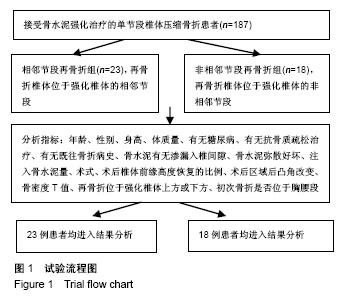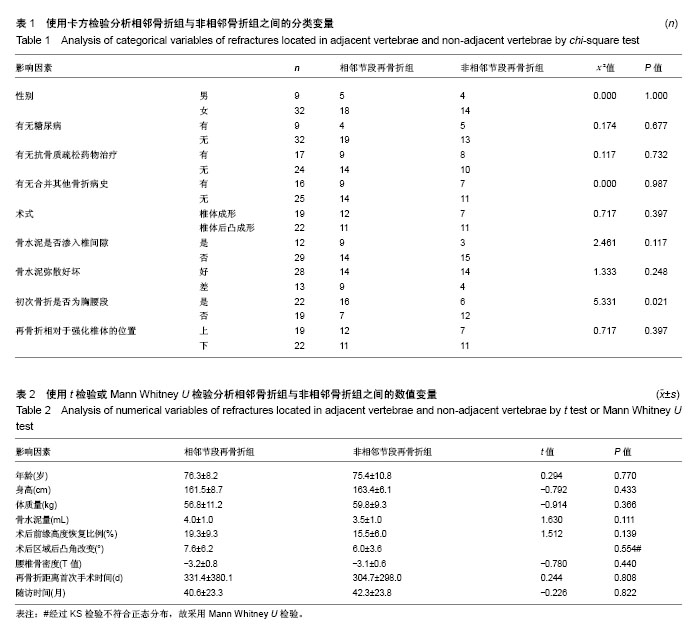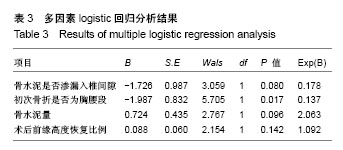| [1] 董平,麻春杰,李舒扬,等.高龄老人骨质疏松骨折的中医保守疗法及护理[J].世界最新医学信息文摘, 2018,18(28):181-182,185.[2] 才久波.口服金天格胶囊联合可塑形胸腰支具治疗老年骨质疏松椎体压缩骨折的临床研究[J].中国医药指南, 2017,15(26): 196-197.[3] 仝尊,张晓刚,赵永利,等.手法复位治疗老年骨质疏松性椎体压缩骨折研究进展[J].亚太传统医药,2017,13(14):71-73.[4] 于前进,唐家广,杨枭雄,等.3种方法治疗老年骨质疏松性椎体压缩骨折的效果对比[J].中国老年学杂志, 2018,38(7): 1633-1636.[5] 于江涛,杨鸫祥.保守治疗老年骨质疏松椎体压缩性骨折研究进展[J].辽宁中医药大学学报,2017,19(10):103-105.[6] 姚松.中医综合保守治疗单纯性胸腰椎压缩骨折的疗效[J].内蒙古中医药,2016,35(15):68.[7] Yu W,Xu W,Jiang X,et al.Risk Factors for Recollapse of the Augmented Vertebrae After Percutaneous Vertebral Augmentation:A Systematic Review and Meta-Analysis.World Neurosurg.2018;111:119-129.[8] Muratore M,Ferrera A,Masse A,et al.Osteoporotic vertebral fractures:predictive factores for conservative treatment failure. A systematic review.Eur Spine J.2017. doi: 10.1007/s00586-017-5340-z.[Epub ahead of print][9] Zhang H,Xu C,Zhang T,et al.DoesPercutaneous Vertebroplasty or Balloon Kyphoplasty for Osteoporotic VertebralCompression Fractures Increase the Incidence of New Vertebral Fractures? A Meta-Analysis.Pain Physician. 2017;20(1):E13-E18.[10] Schousboe JT.Epidemiology of vertebral fracutures.J Clin Densitom.2016;19(1):8-22.[11] Sebaaly A,Nabhane L,Issa EI,et al.Vertebral augmentation: state of the art.Asian Spine J. 2016;10(2):370-376.[12] Petersen A,Hartwig E,Koch EM,et al.Clinical comparison of postoperative results of balloon kyphoplasty(BKP) versus radiofrequency-targeted vertebral augementation(RF-TVA): a prospective clinical study.Eur J Orthop Surg Traumatol.2016; 26(1):67-75.[13] Chen X,Ren J,Zhang J,et al.Impact of cement placement and leakage in osteoporotic vertebral compression fractures followed by percutaneous vertebroplasty.Clin Spine Surg. 2016;29(7):E365-370.[14] Karlsson MK,Kherad M,Hasserius R,et al.Characteristics of prevalent vertebral fractures predict new fractures in elderly men.J Bone Joint Surg Am.2016;98(5):379-385.[15] Kim HS,Ju CI.Spinal instability predictive scoring system for subsequent fracture after bone cement augmentation in patients with osteoporotic vertebral compression fracture. World Neurosug. 2017;106:736-745.[16] Deibert CP,Gandhoke GS,Paschel EE,et al.A longitudinal cohort investigation of the development of symptomatic adjacent level compression fractures following balloon-assisted kyphoplasty in a series of 726 patients.Pain Physician.2016;19(8):E1167-E1172.[17] 黄天霁,寇玉辉,殷晓峰,等.椎体强化术后再发椎体骨折的临床特点和危险因素[J].北京大学学报(医学版),2015,47(2):237-241.[18] Li YA,Lin CL,Chang MC,et al.Subsequent vertebral fracture after vertebroplasty. Spine (Phila Pa 1976). 2012;7(3): 179-183.[19] Rho YJ,Choe WJ,Chun Y.Risk factors predicting the new symptomatic vertebral compression fractures after percutaneous vertebroplasty or kyphoplasty.Eur Spine J. 2012;21(5):905-911.[20] Lin WC,Cheng TT,Lee YC,et al.New vertebral osteoporotic compression fractures after percutaneous vertebroplasty: retrospective analysis of risk factors.J Vasc Interv Radiol. 2008;19(2 Pt 1):225-231.[21] Kim SH,Kang HS,Choi JA,et al.Risk factors of new compression fractures in adjacent vertebrae after percutaneous vertebroplasty.Acta Radiol.2004;45(4):440-445.[22] Chen YC, Lin WC. Can anti-osteoporotic therapy reduce adjacent fracture in magnetic resonance imagine-proven acute osteoporotic vertebral fractures? BMC Musculoskelet Discord.2016;6(17):151.[23] Bae JS,Park JH,Kim KJ,et al.Analysis of risk factors for secondary new vertebral compression fracture following percutaneous vertebroplasty in patients with osteoporosis. World Neurosurg. 2017;99:387-394.[24] Jacobson RE,Palea O,Granville M.Progression of vertebral compression fractures after previous vertebral augmentation: technical reasons for recurrent fractures in a previously treated vertebra.Cureus.2017;9(10):e1776[25] 王吉博.有限元法评估经皮椎体成形和后凸成形治疗脊柱三明治骨折的生物力学变化[J].中国组织工程研究, 2017,21(35): 5703-5708.[26] 李贵星.骨水泥椎体强化术后再发邻椎骨折的综合治疗[J].颈腰痛杂志,2017,38(5):424-427.[27] 罗琦,刘凯.胸腰段骨质疏松性压缩骨折再次骨折的相关因素分析[J].陕西医学杂志,2017,46(9):1215-1216.[28] 唐勇涛,魏思奇,吴长军,等.PKP不同增强方式对相邻椎体结构生物力学影响的有限元分析[J].中国骨科临床与基础研究杂志, 2017,9(3):167-174.[29] 王化明.经皮椎体成形术后椎体压缩性骨折患者再骨折的危险因素分析[J].中国矫形外科杂志,2016,24(4):300-303.[30] Movrin l,Vengust R,Komadina R.Adjacent vertebral fractures after percutaneous vertebral augmentation of osteoporotic vertebral compression farcture : a comparison of balloon kyphoplasty and vertebroplasty.Arch Orthop Trauma Surg. 2010;130(9):1157-1166.[31] Frankel BM,Monroe T,Wang C.Percutaneous vertebral augmentation : an elevation in adjacent-level fracture risk in kyphoplasty as compared with vertebroplasty.Spine J. 2007; 7(5):575-582.[32] 张湛金,王煜巍,陈浩,等.经皮椎体成形术与经皮椎体后凸成形术术后手术椎体再发骨折比较[J].中华骨质疏松和骨矿盐疾病杂志,2017,10(1):20-26.[33] Ahn Y,Lee JH,Lee HY,et al.Predictive factors for subsequent vertebral fracture after percutaneous vertebroplasty.J Neurosurg Spine.2008;9(2):129-136.[34] Lee KA,Hong SJ,Lee S,et al.Analysis of adjacent frature after percutaneous vertebroplasty: does intradiscal cement leakage really increase the risk of adjacent vertebral fracture.Skeletal Radiol.2011;40(12):1537-1542.[35] Wang YT,Wu XT,Chen H,et al.Adjacent-level symptomatic fracture after percutaneous vertebral augmentation of osteoporotic vertebral compression fracture : a retrospective analysis.J Orthop Sci.2014;19(6):868-876.[36] Zhang Z,Fan J,Ding Q,et al.Risk factors for new osteoporotic vertebral compression fractures after vertebroplasty: a systematic review and meta-analysis.J Spinal Disord Tech. 2013;26(4):E150-157.[37] Yoo CM,Park KB,Hwang SH,et al.The analysis of patterns and risk factors of newly developed vertebral compression fractures after percutaneous vertebroplasty.J Korean Neurosurg Soc. 2012;52(4):339-345.[38] Han SL,Wan SL,Li QT,et al.Is vertebroplasty a risk factor for subsequent vertebral fracture,meta-analysis of published evidence?Osteoporos Int.2015;26(1):113-122.[39] Villarraga ML,Bellezza AJ,Harrigan TP,et al.The biomechanical effects of kyphoplasty on treated and adjacent nontreated vertebral bodies.J Spinal Disord Tech. 2005;18(1): 84-91.[40] Fan B,Wei Z,Zhou X,et al.Does vertebral augmentation lead to an increasing incidence of adjacent vertebral failure ? A systematic review and meta-analysis.Int J Surg.2016;36(Pt A):369-376.[41] 王强.椎体强化治疗骨质疏松椎体压缩骨折[J].中国组织工程研究,2015,19(53):8661.[42] 罗晓彬.胸腰段骨折经皮骨水泥强化复位疗效分析[J].湖南师范大学学报(医学版),2018,15(1):181-183.[43] 梁得华,鲁世保.有限元分析法在胸腰段脊柱骨折的应用进展[J].北京医学,2016,38(7):706-708.[44] 程真,陈贵月,郭家斌,等.唑来膦酸对骨质疏松性压缩骨折患者经皮椎体成形术术后骨密度及临床症状的影响[J].山西医药杂志, 2017,46(2):167-170.[45] Yokoyama K,Kawanishi M,Yamada M,et al.Safety and therapeutic efficacy of the second treatment for new fractures developed after initial vertebroplasty performed for painful vertebral compression fractures.Neurol Res. 2013;35(6): 608-613. |
.jpg)



.jpg)